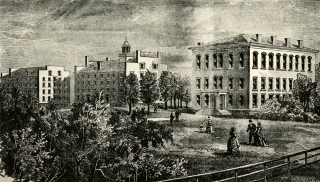bonfire behind the unpartitioned building to the great irritation of people in the village who, seeing the flames through the parallel windows, had rushed up the Hill with buckets to save the structure. By 1862 the first and second stories, which contained a small chapel for everyday purposes, a library, and ten lecture ‘rooms, were at last completed and in use. Since Vogell’s accounts remained unsettled, it fell to Professor Spear to find the money to cover the discrepancies.
Also, through the efforts of Professor Spear in 1868 the University acquired a stone house and ten acres of land adjacent to the campus for the use of President Dodge. Seventeen ladies had contributed $6,000 to buy this property, Mrs. James B. Colgate being the largest donor with $1,300. With this addition, the University in 1869 possessed buildings and grounds worth about $60,000, an increase of approximately $20,000 over 1850.
Losing five out of seven professors to the new University and seminary at Rochester in 1850 posed a serious problem which the Trustees solved by calling three alumni to join Eaton and Spear in the first post-Removal faculty. They were Edmund Turney and Alexander M. Beebee, Jr., who have already been mentioned, and Ezra S.





